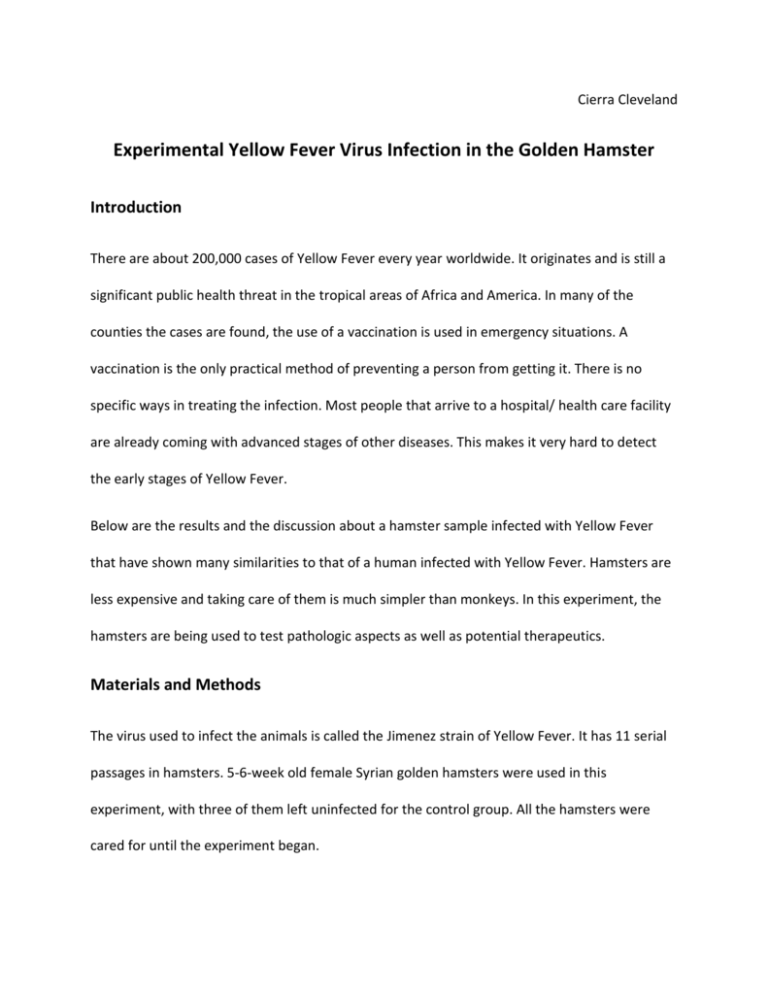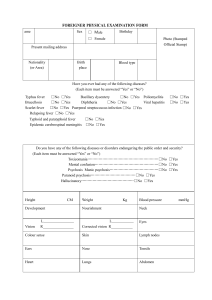Yellow Fever Hamsters - Cierra Cleveland`s ePortfolio
advertisement

Cierra Cleveland Experimental Yellow Fever Virus Infection in the Golden Hamster Introduction There are about 200,000 cases of Yellow Fever every year worldwide. It originates and is still a significant public health threat in the tropical areas of Africa and America. In many of the counties the cases are found, the use of a vaccination is used in emergency situations. A vaccination is the only practical method of preventing a person from getting it. There is no specific ways in treating the infection. Most people that arrive to a hospital/ health care facility are already coming with advanced stages of other diseases. This makes it very hard to detect the early stages of Yellow Fever. Below are the results and the discussion about a hamster sample infected with Yellow Fever that have shown many similarities to that of a human infected with Yellow Fever. Hamsters are less expensive and taking care of them is much simpler than monkeys. In this experiment, the hamsters are being used to test pathologic aspects as well as potential therapeutics. Materials and Methods The virus used to infect the animals is called the Jimenez strain of Yellow Fever. It has 11 serial passages in hamsters. 5-6-week old female Syrian golden hamsters were used in this experiment, with three of them left uninfected for the control group. All the hamsters were cared for until the experiment began. To collect the samples, after 24 hours of being infected, three hamsters were humanely killed every day for nine consecutive days. They were put under deep anesthesia and given a cardiac puncture. The whole blood was saved for experimental purposes and was studied and counts of the white blood cells, red blood cells, neutrophils, monocytes, lymphocytes, basophils, eosinophils, platelets, hematocrit, and hemoglobin. Samples of the liver, spleen, pancreas, kidney, adrenal gland, heart, lung, and intestine were collected, processed and stored. Results In the Clinical studies, normal behavior came from the hamsters the first three days and their organs were normal. 4-5 days after infection, the hamsters became anorexic and lethargic. Their liver and sleep were pale and soft. Day 6 and on, most hamsters appeared emanciated and dehydrated. Some has spontaneous nosebleeds and diarrhea. Apart from the animal sampled, 24 of the hamsters died between days 6 and 7. Internal bleeding was frequently observed. The liver was pale and soft and the spleen was pale soft and enlarged. Serum amalayze values decreased beginning on day 3 and remained low until day 9. This decrease indicates some pancreatic malfunction or insufficiency in the early stages of Yellow Fever. Moderate-to-severe parenchymal necrosis was observed in the pancreas of infected animal beginning on day 5. The only hematologic changes were observed in the platelets and the white blood cells. On day 5 the white blood cells began to increase tremendously, whereas on day 9 they decreased more than five times the maximum increase. The number of platelets remained at a baseline level until day 4, where Thrombocytopenia occurred until day 8. Days 8-9 the count was normal again. Discussion The results obtained in the experiment were similar to those observed in severe human cases of Yellow Fever. The first changes were that of serum transaminases increasing. The same occurs in human cases: the levels increase on day 2 or 3, then peak 2-3 days later, and for those still surviving decrease rapidly over the next week or so. Some blood clotting factors have halflives of less than one day. There was hepatocellular damage and they returned to the baseline for hepatocellular regeneration. These conditions contribute to the hemorrhagic phenomena associated with the disease. The total White Blood Cell count increased between day 5 and day 8, and reached a maximum on day 7. This supports the numerous inflammatory cells in the blood vessels of the tissue sections. Conclusion The hamsters were a notable choice to study. This is because it’s not very often that they are involved in testing regarding the Yellow Fever and they are particularly inexpensive compared to monkeys. They showed many similarities to that of humans infected with the disease. By implicating this experiment, signs of the Yellow Fever have been somewhat detected.











